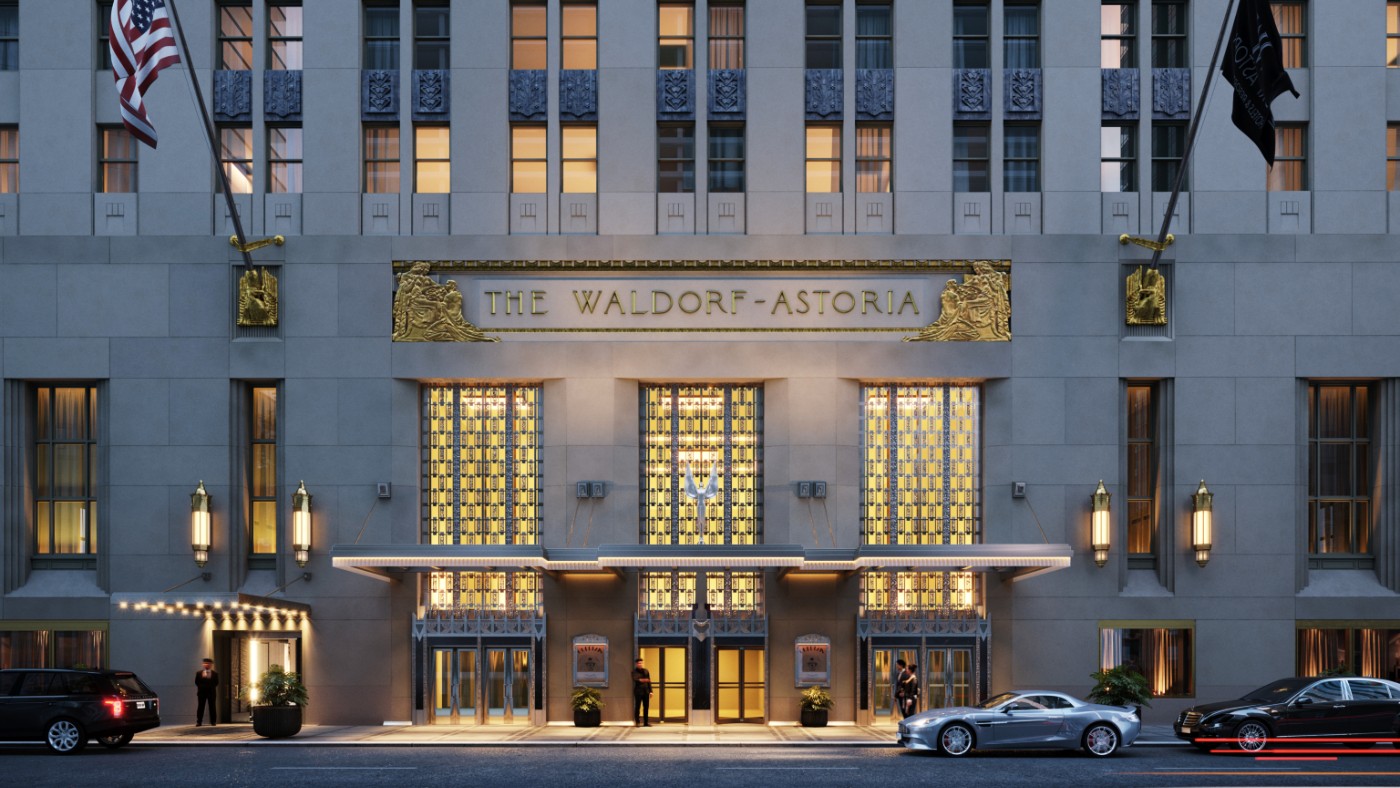Faultless towers: Waldorf Astoria New York sets its course for the future
Iconic Midtown Manhattan hotel is currently undergoing a major renovation

As New York’s first skyscraper hotel, the Waldorf Astoria has been synonymous with effortless luxury and glamour for nearly a century. This Art Deco landmark now proudly takes its place in a world-renowned skyline, but its future was not always so concrete.
The first Waldorf Astoria actually began life as two hotels - The Waldorf and The Astoria - each owned by two feuding members of the fabulously wealthy Astor family. Built on half a block of prime real estate, between 5th Avenue and 33rd Street, “Mrs Astor’s’ 13-storey ‘Waldorf” opened in 1893, gaining an instant reputation for opulence. It was soon outshone, however, by her nephew William Waldorf Astor’s 17-storey “Astoria”, built right next door, in 1897. When the disgruntled Mrs Astor moved uptown the two hotels eventually merged, joined by an alley to form what was at the time the world’s largest hotel.
Playing host to Gilded Age tycoons, American high society and Hollywood stars, it became known as the spot for ladies in the latest couture to rendezvous in comfort and style. It maintained its position at the heart of New York society until the 1920s, when the city’s centre of gravity shifted north.
The Week
Escape your echo chamber. Get the facts behind the news, plus analysis from multiple perspectives.

Sign up for The Week's Free Newsletters
From our morning news briefing to a weekly Good News Newsletter, get the best of The Week delivered directly to your inbox.
From our morning news briefing to a weekly Good News Newsletter, get the best of The Week delivered directly to your inbox.
By the late 1920s, 33rd and 5th in Midtown was no longer a fashionable location. In 1929 the owners sold the land and the hotel was pulled down to make way for the Empire State Building. The manager, Lucius Boomer, procured the rights to the name “Waldorf-Astoria” for a single dollar and, together with a developer and a builder, purchased the site where the Waldorf-Astoria as we know it currently sits. They chose a Park Avenue location for proximity to the recently built Grand Central Station, hedging their bets that, over time, the new hotel would transform a residential area into a booming commercial hub. With 1,400 rooms to fill, this was a major gamble. In fact, they broke ground just weeks before the stock market crash that plunged America into depression.
The build took only 14 months, a major feat as the tallest and largest hotel in the world. Opening to rapturous reviews in 1931, it quickly became the place to be seen in New York, hosting major events in the society calendar and celebrity weddings. This was New York’s living room - where the city came to celebrate. Some even set up home in the Waldorf Astoria as permanent residents. Celebrities like Cole Porter, Marilyn Monroe and Frank Sinatra all moved in, Sinatra for a reported $1m a year. A piano of Porter’s, lovingly restored by its Brooklyn maker Steinway, remains in situ.

A new incarnation of an icon
After nearly a century in its current location, a $1bn (£719.4m) renovation is currently underway for reopening as a hotel with private residences in early 2023. Having rather fallen out of fashion, key to today’s project is revitalising the building and re-igniting the spirit that so rooted it to the American modern age.
A free daily email with the biggest news stories of the day – and the best features from TheWeek.com
Once complete, the iconic property will include 375 condominium residences and 375 rooms of the Waldorf Astoria New York hotel.
Jean-Louis Deniot, the renowned designer behind many of the world’s most luxurious private homes, has reinvigorated the Waldorf’s original Art Deco interiors with contemporary luxury, creating modern living within its historic structure, ranging from studios to two unique penthouses situated in The Towers.
The space has more than 50,000 sq ft of residential amenities, the centrepiece of which is the 25m Starlight Pool. It overlooks Park Avenue and is lit by a restored skylight, an architectural feature lost for 70 years and now returned to its glorious former purpose.
Private bars, salons and game rooms abound, a tipping of the hat to the celebrated entertaining spaces that once drew New York society to the original hotel.
As so it returns, brick by brick, to become a new incarnation of an icon; it nods to history but the Waldorf Astoria has now set its course for the future.
The Towers of the Waldorf Astoria New York will offer 375 residences starting from $1.8m (£1.26m). Occupancy is projected for early 2023. For more information see waldorftowers.nyc
-
 ‘It’s another clarifying moment in our age of moral collapse’
‘It’s another clarifying moment in our age of moral collapse’Instant Opinion Opinion, comment and editorials of the day
-
 Trump vows naval blockade of most Venezuelan oil
Trump vows naval blockade of most Venezuelan oilSpeed Read The announcement further escalates pressure on President Nicolás Maduro
-
 Political cartoons for December 17
Political cartoons for December 17Cartoons Wednesday's political cartoons include healthcare costs, the affordability hoax, giving up pencils, and more
-
 Why photo booths are enjoying a revival
Why photo booths are enjoying a revivalIn The Spotlight It’s 100 years since it first appeared, but the photo booth is far from an analogue relic
-
 Black Rabbit: slick crime thriller set in a high-end New York restaurant
Black Rabbit: slick crime thriller set in a high-end New York restaurantThe Week Recommends Two Manhattan brothers resort to ‘ever-more high-stakes’ schemes to tackle ‘huge’ gambling debts in the ‘glossy’ series
-
 Say farewell to summer at these underrated US lakes
Say farewell to summer at these underrated US lakesThe Week Recommends Have one last blast
-
 Not every hike has to wipe you out. These 7 treks are easy-breezy.
Not every hike has to wipe you out. These 7 treks are easy-breezy.The Week Recommends These trails won't leave you breathless
-
 Food trails are the best trails. Eat your way across the US with these 7 regional food journeys.
Food trails are the best trails. Eat your way across the US with these 7 regional food journeys.The Week Recommends Take a bite out of the United States
-
 Sex, drugs and a royal ruckus: the US play with a future gay Prince George
Sex, drugs and a royal ruckus: the US play with a future gay Prince GeorgeTalking Point The controversial off-Broadway show is a hit with audiences in New York
-
 Art review: Rashid Johnson: A Poem for Deep Thinkers
Art review: Rashid Johnson: A Poem for Deep ThinkersFeature Guggenheim New York, through Jan. 18
-
 7 festive hotels that get decked out for the holidays
7 festive hotels that get decked out for the holidaysThe Week Recommends These properties shimmer and shine all December long